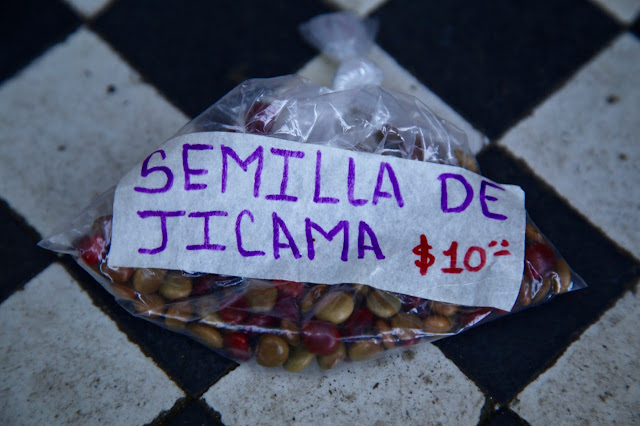There are few herbs quite as pungent in their aroma as
basil: a heady, clove fragrance with notes of liquorice and cinnamon in there
as well. In The Flavour Thesaurus, Niki Segnit calls the taste of basil akin to
“sucking on a sweet rusty nail”, which is an evocative description though I’d say
it’s much more pleasant than that.
Basil is best used fresh. Dried basil is pretty tasteless, frozen
can be OK, although much of the flavour is lost and you certainly don’t get
that fragrance hit that you get with the fresh growing leaf.
The supermarkets will sell you sweet, or Genovese, basil
growing in a pot. If you’re lucky you can keep this growing for several weeks,
supplying you with fresh leaves when you need them. Once you get the pot home,
unwrap the cellophane wrapping, stand it in a drip tray and water really
thoroughly. Then place it in as bright a position as possible – a south-facing
windowsill is ideal - and keep the soil moist. When you pick the leaves, don’t
denude the stems completely: you can cut the stems to just above the first set
of true leaves and it should regrow.
Although Genovese basil, with its punchy aroma, is the
classic version for making pesto, it’s only one of many different varieties.
Milder in flavour but with large, floppy lettuce-like leaves, is Neapolitan
basil – great for wrapping small balls of mozzarella or tearing over a pizza.
Purple basil brings dramatic colour to salads. Greek basil has tiny leaves but
great fresh taste. Lemon, lime, and pineapple basils bring an astringency to
the classic clove fragrance and cinnamon basil adds warmth.
 |
| Greek basil leaves are much smaller, with a slightly milder, sweeter flavout. |
There is a greater difference in flavour in the Asian
basils: Thai, and holy basils. These give Thai dishes, especially curries, those
quintessential anise notes. Basil Ararat, appropriately enough, has a distinctive
flavour halfway between the two.
These varieties are all just as easy to grow as Genovese
basil but are almost impossible to find in the shops - you may occasionally find Greek basil plants in Sainsburys and Waitrose, and Thai basil leaves in the latter. Luckily you can find the
seeds in some major and many specialist catalogues, and now is the time of year
to start thinking about sowing them.
After a lot of experimentation I’ve come to the conclusion
that in the UK, basil is an indoor plant. Its fleshy leaves don’t stand up well
to wind and rain, they fall prey to slugs and snails and act as a magnet for
greenfly. Better tend them indoors and cosset them.
Basil needs light and warmth to grow well. Sown in February,
the emerging seedlings can take advantage of the increased daylight hours in
March to put on strong growth and keep you in basil right through the summer.
All basil varieties can be grown the same way. Fill a
medium-sized pot – you need one at least 16cm across to get a decent crop –
with multi-purpose compost to 2cm below the brim. Water well. Sprinkle the basil
seeds over the surface in a single layer – two pinches should be enough. Similarly,
sprinkle more compost over the seeds, just enough to barely cover them. Put a
clear polythene bag over the pot and place it somewhere sunny and warm. You
should see the seedlings start to emerge in three to six days – you can then remove
the plastic bag.
Keep the soil nice and moist and you should have leaves ready
to cut in a couple of months’ time. So long as you don’t remove all the leaves
from any one stem, harvesting will make the plant grow back more strongly and
your pot sown now will keep you in basil for the rest of the summer.


















